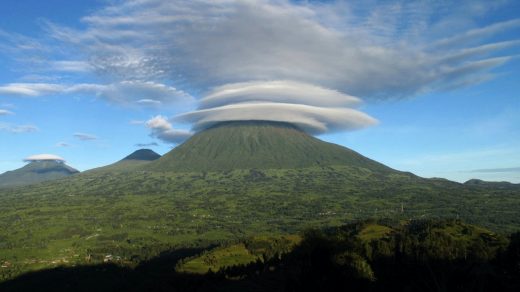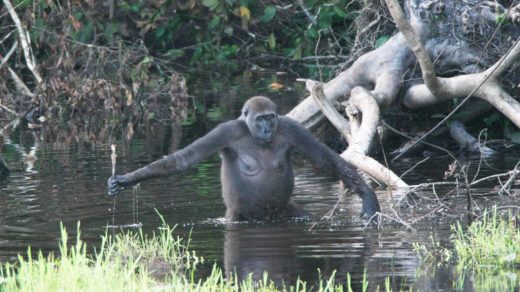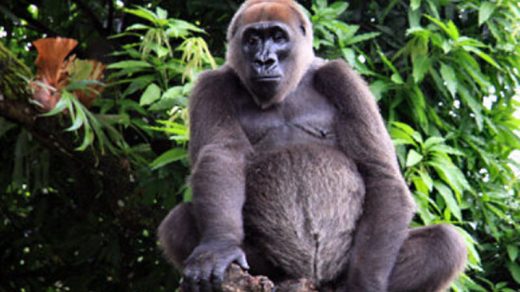Established in 1991, Mgahinga Gorilla National Park is found in south-western Uganda and governed by the Ugandan Wildlife Authority.
At the latest survey, around 30 mountain gorillas lived in the park, forming three different groups. One of the groups is habituated to human presence (e.g. researchers and eco tourists) while the other two have been deliberately kept un-habituated. Tourists are only allowed to visit the habituated group – the Nyakagezi Gorilla Group.
The gorillas in the park live in families, and each family is led by a strong male gorilla – a silverback. The silverback is responsible for protecting the family from threats, and will typically decide when and where to the family will move. The gorillas move around a lot in the forest, looking for tasty plant leaves and other desirable food sources. They also need to find good nest spots, as they build nests and stay in them during the night. Because of this, it is not possible to know in advance exactly where and at which altitude members of the Nyakagezi Gorilla Group will be when eco tourists come to visit, and how far they will be from any road. Sometimes, visitors needed to hike on foot for up to eight hours before reaching the gorillas. When you come to visit gorillas in this park, the gorillas´ well-being are the priority – as it should be.
This park is connected to two other national parks: Volcanoes National Park in Rwanda and Virunga National Park in the Democratic Republic of the Congo (DRC). Together, the three parks form a large protected area in this mountainous border region.
In the 1930s and 1940s, the area that is now Mgahinga Gorilla National Park was a game reserve, with some agriculture taking place at lower altitudes. Preparation work for a national park was initiated in the late 1980s, when biological surveys were carried out, rangers recieved training, and projects were launched to plant trees and remove traps. In the early 1990s, settlers were relocated to areas outside the protected land.
How large is Mgahinga Gorilla National Park?
It covers an area of 33.9 square kilometres. This makes Mgahinga Gorilla National Park the smallest of Uganda´s national parks, but it is connected to two other national parks in the neighbouring countries and thus part of a large protected area. All three parks are part of the Virunga Conservation area, and the three parks together cover 434 square kilometres.
Where is Mgahinga Gorilla National Park?
The park is found within the Bufumbira County of the Kisoro District, in south-western Uganda. It is located within the Virunga Mountains and is a part of the Nile River watershed area.
Coordinates: 01°22′10″S 29°38′25″E
The closest town is Kisoro, which is roughly 15 km by road north of the park.
The environment
Mgahinga Gorilla National Park is a part of the Virunga Mountains, and the altitude within the park ranges from 2,227 to 4,127 metres. Three inactive volcanoes are present within the park – Mount Muhabura, Mount Gahinga, and Mount Sabyinyo – and their partly forested slopes forms important wildlife habitats.
The dominating habitat types are:
- Bamboo forest
- Albertine Rift montane forest
- Ruwenzori-Virunga montane moorland with tree heather (Erica arborea)
- Alpine (at higher altitudes)
The area have two rainy seasons: One from February to May, and then a second one from September to December. The rainiest month is October, with an average rainfall of 250 mm. The dryest month i July, which will get around 10 mm of rainfall during an average year.
Wildlife
Both mountain gorillas (Gorilla beringei beringei), Colobus monkeys, and golden monkeys (Cercopithecus kandti) live in the park. The golden monkeys are endemic to the Albertine Rift region, and are currently only found in the Virungas and in one other forest in Rwanda.
Examples of other mammals living the park are leopard, elephant, buffalo, giant forest hog, bushpig, bushbuck, black-fronted duiker, and several species of bat.
Examples of birds recorded in the park during the 2004 survey are Rwenzori turaco, Rwenzori batis, Rwenzori double-collared sunbird, Kivu ground thrush, Archer’s ground robin, stripe-breasted tit, blue-headed sunbird, Grauer’s swamp warbler, red-faced woodland warbler, handsome spurfowl, dusky crimson-wing, red-throated alethe, collared apalis, mountain masked apalis, regal sunbird, strange weaver, and montane nightjar.


